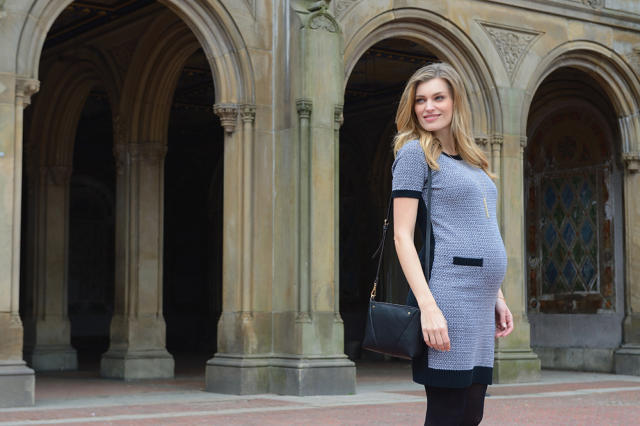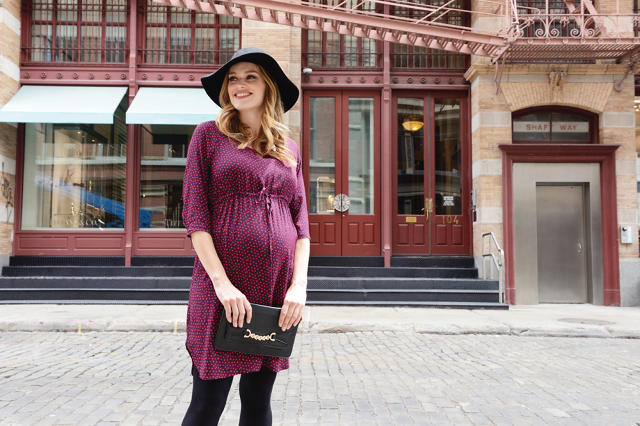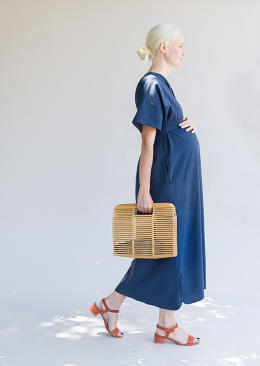Niche Maternity Retailers Surge As Millennial Moms Redefine The Category
Maternity wear is a $2 billion domestic industry serving over 6 million American pregnant women each year, so why has it been treated like a stepchild for so long?
When Courtney Klein founded the modern maternity label Storq in 2013, she sought to bring maternity wear into the realm of high fashion. Frustrated by what she called “the black hole for good taste,” Klein launched a line of soft, versatile basics in classic, minimalist styles that used high-quality fabrics, like stretchy modal jerseys in neutral colors, that can easily be layered into one’s existing wardrobe.
Klein believes that women can be mothers without being fashion martyrs, a philosophy that resonated with frustrated consumers. Storq’s sales are up 70% year-to-date, and the company intends to double their inventory in the coming year, extending into nursing and parenthood products.
“Women with a strong sense of personal style feel alienated by maternity and perceive the industry as a whole to be cheap and unfashionable,” explained Klein of her desire to pursue well-made pieces at an accessible price point. “Why not design pieces just for them that look like the things they would normally buy for themselves? We wanted to create a genuine sense of value and prestige in purchasing pieces designed specifically for maternity.”
Storq is one of many new brands livening up this once ignored clothing category. New online labels such as Hatch are rapidly growing, while established brands like ASOS and Topshop have successfully branched out into the maternity market. What used to be limited to a few players is now a battleground for multiple competitors reaching out to moms-to-be. Sales at former strongholds, traditional brick-and-mortar maternity stores, are down and expected to further decline. Destination Maternity, which accounts for 20% of the market, will close 25 to 30 stores in 2016.
Sales are declining, explained IBISWorld industry analyst Madeline Hurley, because retailers continue to be mass-focused, trying to meet the needs of too many. Meanwhile, online retailers catering to niche tastes are thriving in this market. The average age for first-time mothers is also rising gradually, which means women are more established in their careers by the time they pursue motherhood. That means they have more money to spend on fashionable maternity wear. “Women want to feel beautiful whether they’re nine months pregnant or not,” says Hurley.

Style Identity
Actress Blake Lively donned designer labels like Gucci and Valentino while pregnant, with fashion magazines labeling her “one the most stylish pregnancies on record.” Granted, the designer wardrobe was custom-tailored; nothing was off-the-rack, nor just a bigger size of a certain style.
“Basically, [celebrities] are wearing maternity clothing, even if they’re not wearing maternity designers,” says TV personality Rosie Pope, who launched her own maternity line in 2008.
Pope was the star of the former Bravo series Pregnant in Heels, which chronicled her adventures as a kind of “maternity concierge” for millionaire parents-to-be. The show’s debut coincided with the time Hollywood stars became more invested in maternity wear, thereby inspiring fans to emulate red-carpet bumps. It prompted Pope to jump into the market herself.
“I was shocked at this major moment in life that celebrities and media had caught on to, but fashion hadn’t; there was a big void,” says Pope. “I lived in New York City, a place where you’d think you could find [stylish maternity clothes], but there was still really nothing to wear.”
Pope realized maternity lacked competition. Her line offers styles of the moment: cinch dresses, body-con silhouettes, and leggings in knit performance fabrics. “If the off-the shoulder [trend] is happening in fashion, you should be able to get that in maternity,” stressed Pope. “We’re giving people the fashion that they want but in the shapes that fit them. If she’s pregnant or not, she wants what’s on the runway.”
Rosie Pope Maternity is available on its online channel as well as in mass retailers like Amazon.com, BuyBuy Baby, and Nordstrom. It’s one of fastest growing maternity brands, accounting for 1.1% market share. IBISWorld estimates it will reach over $20 in revenue in 2016.
Pope contributes her success to women celebrating their bodies, no longer hiding their growing shape underneath billowy dresses of decades past. “I see women being nicer to themselves than they ever have before,” says Pope. “I think finding maternity clothes that give you confidence and that ability to treat yourself and feel good about this stage is a really beautiful thing. It’s important for women.”
Seraphine is another company catering toward fashion forward proto-moms. Celebrities like Olivia Wilde and Mila Kunis, as well as all three Swedish princesses, are big fans of the label, which features wrap dresses in bright prints, chic wool coats in cool pastels, and polka dot capris.”With so many high-profile pregnancies in the press in recent years, and of course the rise of the mommy blogger, women are becoming more and more confident about showing off their curves,” Seraphine founder Cecile Reinaud says of young moms who similarly want form-fitting ensembles. “Women are no longer content to settle for shapeless tent dresses, so designers have upped their game to meet demand.”
The celebrity influence is a strong one: After Duchess Kate wore a fuschia-colored Seraphine dress for the first royal family portrait with Prince George in 2013, the company sold 20,000 units of the style (after the website, which initially crashed, was up and running again).
“Over the past three years, we’ve built on that initial boost to expand our reach into new territories and to secure our place as an industry-leading maternity wear retailer,” explained Reinaud. The company has grown 25% over the last year and will now expand into areas such as Dubai. “Having such an impressive celebrity following definitely bolsters both sales and brand recognition—especially in the States, where many of our celebrity clients are based.”

The Millennial Mom
The average age of first birth has increased from 24.9 in 2000 to 26.3 in 2014, according to the latest date by the CDC. That makes many first-time moms millennials more willing to purchase premium-level clothing.
“The whole idea of maternity wear is really changing with this generation of millennial parents and what they’re willing to spend to look stylish and feel comfortable throughout their pregnancy,” says Julia Wang, director of digital content for TheBump.com. Her readers invest in staples pieces like a maternity bra or black pants, but also want items that mirror their current fashion taste.
“They’re looking for silhouettes that they’re already wearing,” rather than conforming their style to accommodate their growing form, she says. Some companies successfully meld trends with more forgiving cuts. She cites the current collaboration between Hatch and designer Current/Elliott as a prime example of a collaboration that fulfills a younger generation’s interest in sticking to accustomed fashion.
Millennials have strong brand loyalty, so it makes sense companies cater to their lifestyle needs, not only in terms of style but also the shopping experience, like points programs or free shipping and returns. Engaging with consumers during pregnancy fosters a strong relationship with brands, one that continues once they’re done with their pregnancy.
That’s why Storq extended into nursing-wear and diaper bags last season. Storq customers, following their births, requested the startup tackle their next hurdle: parenthood.
“There are these certain crucial moments in your life where if you make a connection with a brand, then you’re much more likely to keep that connection,” explained Klein. “It’s such a formative time in your life…. if you have a great experience with brand during those moments, it sticks with you.”
Bigger retailers quickly adopted the pattern. Topshop, H&M, The Gap, and more mainstream fashion companies further invested in their maternity offerings, giving consumers what they’re accustomed to pre-pregnancy.
As Wang says, “It’s a win for the consumer and the brand.”
Fast-fashion retailer ASOS, for example, made trendy styles—skater dresses in bright prints, clingy tops with strategic cut-outs, and stretchy jumpsuits—available in maternity sizes.
“Many more brands now offer maternity ranges, which has meant the customer has more on offer but we have managed to continue to grow by ensuring that we always have the newest styles as well as pieces for every occasion at an affordable price point,” says Eef Vicca, ASOS senior director of fashion.

Improving The Math
Preparing for parenthood is an expensive endeavor, and first-time parents weigh costs, especially when it comes to clothing with a foreseeable end date.
“The baby industrial complex is amazingly strong at making people feel like they have to have all this stuff,” says Storq’s Klein, whose company tackles such anxiety by pushing basics that can be worn from start to finish throughout one’s pregnancy. Klein observes women struggling to justify spending money on themselves when an avalanche of stuff has yet to be bought for the baby’s room. There’s also the inner calculus of cost-per-wear, which is only amplified when buying clothes to wear for a finite time. It’s why the company sells direct to consumer: to reduce costs.
“We’ve found that by working outside of the seasonal wholesale model, it is possible to make nice things at a reasonable cost,” says Klein. “Going direct to consumer gives us an important degree of flexibility in how and when we get things made. We also make every effort to ensure that what we produce is truly essential.”
Some companies make clothes designed to go even beyond the nine months, making an even larger claim for cost-per-wear. Hatch was launched in 2011 as a collection of wardrobe essentials intended for wear before, during, and after pregnancy. It features items ranging from button-down shirts to trendy faux leather leggings.
“I believe that a woman’s style should be a continuum,” says Hatch founder and CEO Ariane Goldman of her line’s duality. “You should feel like yourself and comfortable in your wardrobe through all of life’s stages, whether during pregnancy or just as your body changes.” Hatch has grown 45% season-over-season, and 30% of their customers aren’t even pregnant. Goldman sees the growth as a testament to women wanting their specific style of clothing, instead of clothing that feels “maternity-only.”
Like Storq, Hatch wants to shift perceptions, to enable women to feel good about purchasing quality maternity pieces rather than buy pieces that are poorly made and disposable. “Women are investing in a handful of versatile items,” confirms Goldman.
The Comfort Conundrum

The brand Isabella Oliver also markets itself as a pre-, during-, and post-pregnancy line. Launched 13 years ago, it was handpicked by Hollywood A-listers like Gwen Stefani and Halle Berry, although only during their pregnancies. The brand focuses on comfortable core classics, within a few seasonal trendy items thrown in.
“[Maternity] is all about comfort,” says Baukjen de Swaan Arons, creative director at Isabella Oliver, who has seen a huge uptick in the brand’s athleisure-wear section. “Comfort is key to every style that we design: we incorporate hidden techniques and design details like internal shelf bras, bra strap loops, all the little details that make a big difference.”
Comfort was not always at the forefront of maternity wear. Today’s leading brands better incorporate top fabrics as well as reconsider the positioning of elastics, side zippers, and tags that could irritate the body. “It’s no longer polyester and flammable materials: These are really comfortable, soft materials that you would want against your skin,” TheBump.com’s Julia Wang says.
“Customers want clothing that is stylish, that feel comfortable, and that won’t break the bank,” says Wang, “and many brands are delivering on all three of those.”
Despite all of the new brands in maternity, there’s still room for more competitors. “There always will be women that will need maternity clothing,” says IBISWorld’s Hurley. “[Companies] should definitely try to establish their market better—either go for the fast-fashion type model or more upscale and downsize their stores, trying to expand their online presence.”
These labels—and new ones—just need to find the next black hole in need of sartorial help. With this niche-serving market, moms-to-be won’t dread what was once a painful chore. As Rosie Pope remarked, “People are now excited to go maternity shopping.”
Related Video: How Paid Leave Benefits Everyone
Fast Company , Read Full Story
(22)


